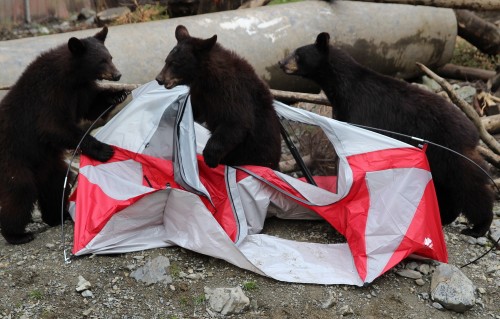
About a hundred fifth-graders turned out in Sitka recently to watch a trio of captive brown bears destroy a small tent that had been “baited” with fried chicken.
While the demonstration was a very graphic way to convey an important message about safety, it was also a step toward not doing this kind of project in the future. The directors of Sitka’s Fortress of the Bear hope to one day rehabilitate orphaned animals with as little human contact as possible, and then release them into the wild.
Tennie Bentz is an education specialist with the Alaska Department of Fish & Game. She does this messy camp exercise in schools in Juneau and Sitka — but in Sitka she gets to use real bears.
“In the past we set up a campsite behind Keet (Gooshi Heen Elementary School). We show the kids the tent,” Bentz says We make a messy campsite. We go back into the classroom and that’s it. And so this way we’re actually able to show what would happen if they left a messy campsite.”
During the demonstration, other ADF&G staff have set up video cameras to capture the exercise. They’ll give the tape to Sitka High School students to prepare a bear safety TV commercial.
After the fifth graders have piled back into buses and gone back to school, they set up another tent in a smaller area set aside for three black bear cubs, Smokey, Bandit, and Tuliaan, who were orphaned in Juneau and Seward in 2013. Then they sit back, and watch.
The black bears, which weigh from 150 to 250 pounds, take a little more time as they devour the dog kibble and grapes inside the tent. They’re playful. They pull apart the tent poles, and chew on the bungee cords. They wrestle a bit. But eventually the tent is shredded, and they stretch out among the ribbons like tired puppies.
Les Kinnear used to be a hunting guide and is now executive director of the Fortress of the Bear. He hunted bears, among other things, in the Alaska Range, and says one of his fellow guides, especially, was notorious for leaving a messy camp.
“So it was kind of a toss-up, whether a bear had been there or not. The only way you could really tell was if the skillet was clean. You knew it was a bear.”
This kind of education outreach was in the plan when he and his wife Evy took on the project of converting former mill structures into a 60,000 square foot bear habitat eight years ago.
“It’s all part of the ongoing process,” Kinnear says. “We hope someday to expand and create an area where we can bring the next generation of orphan cubs to raise remotely, until they’re big enough, fast enough, strong enough, smart enough to take care of themselves. And start a pilot project here in Alaska putting them back in the wild where they belong.”
That won’t happen for these animals, unfortunately. The Fortress of the Bear sent triplet brown bear cubs to the Bronx Zoo in 2009, after their mother was accidently killed by police in Sitka. Another orphan black bear cub went to a wildlife sanctuary in Texas in 2010. But these bears will live out their lives here — maybe up to 30 years, according to state biologist Phil Mooney, who orchestrated today’s demonstration. He believes these bears remind us of our role in creating orphaned and captive bears.
“If they were really as violent as some people believe, we’d have a lot more people taking beds at the community hospital,” Mooney says.
In the meantime, the Fortress bears will do this job over and over again for students. And sooner or later, Mooney says, they’ll figure out that a tent just means fried chicken.